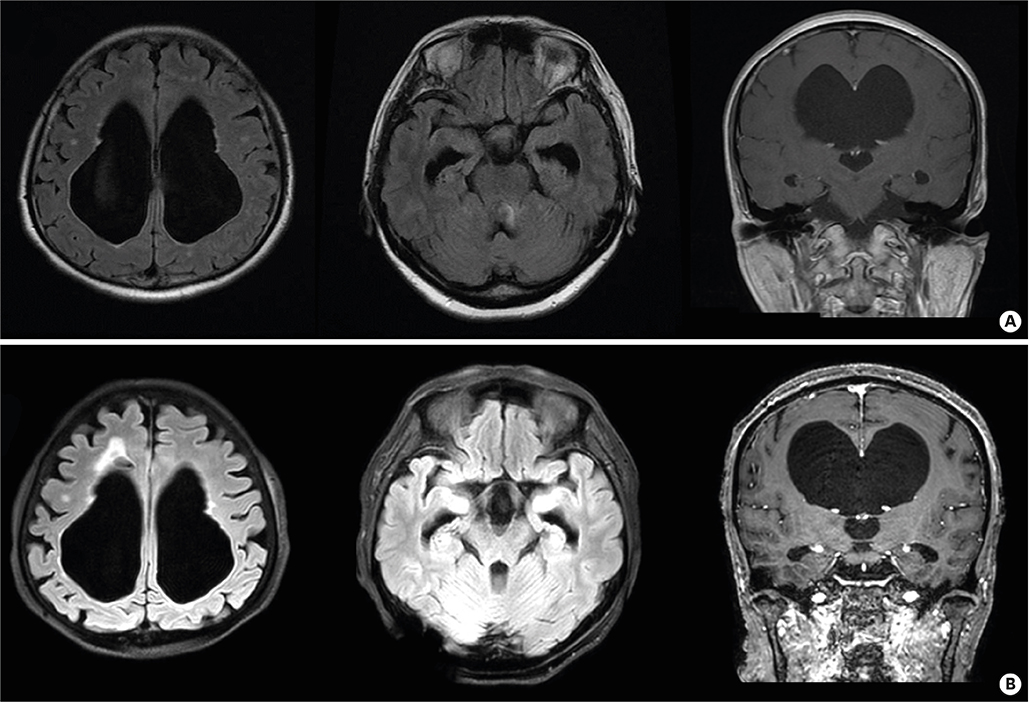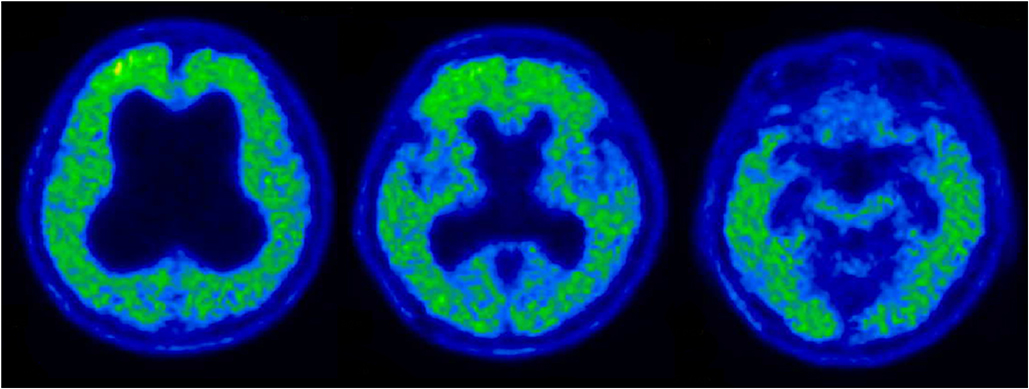Dement Neurocogn Disord.
2018 Mar;17(1):32-36. 10.12779/dnd.2018.17.1.32.
Hydrocephalus in a Patient with Alzheimer's Disease
- Affiliations
-
- 1Department of Neurology, Seoul National University Bundang Hospital, Seongnam, Korea.
- 2Department of Neurology, Wonkwang University School of Medicine, Iksan, Korea. md0626@naver.com
- KMID: 2442815
- DOI: http://doi.org/10.12779/dnd.2018.17.1.32
Abstract
- BACKGROUND
Normal pressure hydrocephalus (NPH) is an etiology of dementia that is reversible following cerebrospinal fluid shunt placement, however, surgical intervention not always clinically effective and the respons to shunt therapy is poorly understood. Furthermore, NPH is a source of comorbidity in diseases with neurodegenerative pathology, such as Alzheimer's disease (AD).
CASE REPORT
A 61-year-old woman presented to the neurology clinic with progressive gait difficulties and cognitive impairment over five years. Nine years after ventriculoperitoneal (VP) shunt treatment, the patient began to experience frequent falls. There was no improvement in clinical symptoms after the alteration of valve pressure on the VP shunt. An 18F-florbetaben amyloid positron emission tomography scan showed increased diffusion uptake over the bilateral cortices, precuneus, and posterior cingulate cortex.
CONCLUSIONS
The patient of NPH was unresponsive to shunt therapy due to the development of AD.
Keyword
MeSH Terms
Figure
Cited by 1 articles
-
The Impact of Comorbid Alzheimer's Disease in a Patient with Normal Pressure Hydrocephalus?
Halil Onder
Dement Neurocogn Disord. 2020;19(1):31-32. doi: 10.12779/dnd.2020.19.1.31.
Reference
-
1. Hakim S, Adams RD. The special clinical problem of symptomatic hydrocephalus with normal cerebrospinal fluid pressure. Observations on cerebrospinal fluid hydrodynamics. J Neurol Sci. 1965; 2:307–327.
Article2. Shprecher D, Schwalb J, Kurlan R. Normal pressure hydrocephalus: diagnosis and treatment. Curr Neurol Neurosci Rep. 2008; 8:371–376.
Article3. Ishikawa M, Hashimoto M, Kuwana N, Mori E, Miyake H, Wachi A, et al. Guidelines for management of idiopathic normal pressure hydrocephalus. Neurol Med Chir (Tokyo). 2008; 48:Suppl. S23.4. Wood JH, Bartlet D, James AE, Udvarhelyi GB. Normal pressure hydrocephalus: diagnosis and patient selection for shunt surgery. Neurology. 1974; 24:517–526.
Article5. Golomb J, Wisoff J, Miller DC, Boksay I, Kluger A, Weiner H, et al. Alzheimer's disease comorbidity in normal pressure hydrocephalus: prevalence and shunt response. J Neurol Neurosurg Psychiatry. 2000; 68:778–781.
Article6. Del Bigio MR, Cardoso ER, Halliday WC. Neuropathological changes in chronic adult hydrocephalus: cortical biopsies and autopsy findings. Can J Neurol Sci. 1997; 24:121–126.
Article7. Savolainen S, Paljarvi L, Vapalahti M. Prevalence of Alzheimer's disease in patients investigated for presumed normal pressure hydrocephalus: a clinical and neuropathological study. Acta Neurochir (Wien). 1999; 141:849–853.
Article8. Messert B, Wannamaker BB. Reappraisal of the adult hydrocephalus syndrome. Neurology. 1974; 24:224–231.9. Huckman MS. Normal pressure hydrocephalus: evaluation of diagnostic and prognostic tests. AJNR Am J Neuroradiol. 1981; 2:385–395.10. Malm J, Kristensen B, Stegmayr B, Fagerlund M, Koskinen LO. Three-year survival and functional outcome of patients with idiopathic adult hydrocephalus syndrome. Neurology. 2000; 55:576–578.
Article11. Iddon JL, Pickard JD, Cross JJ, Griffiths PD, Czosnyka M, Sahakian BJ. Specific patterns of cognitive impairment in patients with idiopathic normal pressure hydrocephalus and Alzheimer's disease: a pilot study. J Neurol Neurosurg Psychiatry. 1999; 67:723–732.
Article12. Savolainen S, Laakso MP, Paljärvi L, Alafuzoff I, Hurskainen H, Partanen K, et al. MR imaging of the hippocampus in normal pressure hydrocephalus: correlations with cortical Alzheimer's disease confirmed by pathologic analysis. AJNR Am J Neuroradiol. 2000; 21:409–414.13. Jagust WJ, Friedland RP, Budinger TF. Positron emission tomography with [18F] fluorodeoxyglucose differentiates normal pressure hydrocephalus from Alzheimer-type dementia. J Neurol Neurosurg Psychiatry. 1985; 48:1091–1096.
Article14. Silverberg GD, Mayo M, Saul T, Rubenstein E, McGuire D. Alzheimer's disease, normal-pressure hydrocephalus, and senescent changes in CSF circulatory physiology: a hypothesis. Lancet Neurol. 2003; 2:506–511.
Article
- Full Text Links
- Actions
-
Cited
- CITED
-
- Close
- Share
- Similar articles
-
- The Impact of Comorbid Alzheimer's Disease in a Patient with Normal Pressure Hydrocephalus?
- Pisa Syndrome in a Patient with Alzheimer's Disease and Concomitant Normal Pressure Hydrocephalus: A Case Report
- Is Brain Biopsy Rational in Shunt Operation of Normal Pressure Hydrocephalus in Elderly?
- Memorials of Alois Alzheimer (June 14, 1864~December 19, 1915) and Historical Background of Alzheimer's Disease
- Significance of Non-Alzheimer Dementia



